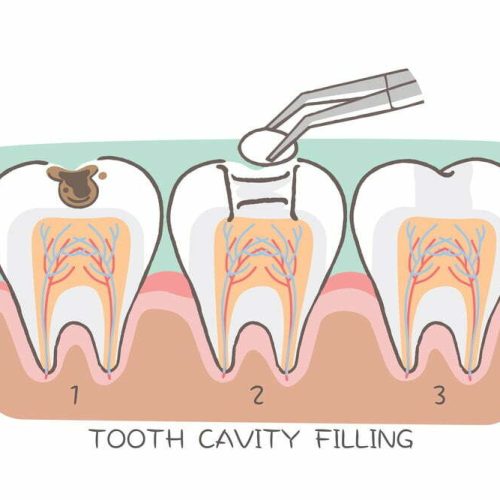Dental Fillings In Winnipeg
If your tooth has a cavity, you may not even notice it. Cavities typically don’t cause pain until the decay reaches the nerves of the tooth. At that point, the damage can’t be reversed—you’ll need to visit the Winnipeg dentist to prevent a tooth infection.
Dental fillings are used to repair teeth that have cavities, cracks, or chips. They restore the appearance and structure of a decayed tooth. Depending on which tooth has a cavity, you may prefer one type of filling over another.
What Are The Different Types Of Dental Fillings?
Instead of extracting a damaged tooth, dentists can repair the cavity using filling materials. To give you an idea of your options in Winnipeg, MB, we’re going to explain the pros and cons of each type of dental filling:Composite fillings
One of the most popular choices for dental fillings is composite resin. This material creates a completely natural look as it’s been colour-matched to your surrounding teeth.White composite fillings might be the most aesthetically pleasing option, but they have a few downsides. They aren’t as durable as other types of dental fillings, which means they’re more prone to breaking and cracking. You may need to replace a composite filling sooner than you would a metal filling.Even if you don’t have a cavity, composite fillings can be used to repair broken teeth. Your dentist can seamlessly repair chips and cracks in your front teeth, and no one will know the difference. If you want to preserve the appearance of your natural teeth, white fillings might be the right choice for you.Amalgam fillings (Silver fillings)
Dental amalgam fillings are made of metals like copper, silver, tin, and mercury. This filling material is typically used on molars since it’s durable enough to withstand the chewing forces of your jaws. Silver fillings are rarely used on front teeth; they are highly noticeable due to their bright colour.These dental fillings are applied directly to the teeth, which means you can have a cavity filled and repaired in just one appointment. With the proper care, they can last for many years.Gold fillings
If you’re looking for a strong and long-lasting material, a gold filling is a great option. But this enhanced durability comes at a cost—gold fillings are the most expensive of all. Keep in mind that you’re paying extra for the cost of gold as well as their longevity and strength.Like amalgam fillings, gold fillings are quite noticeable, and some patients prefer the gold material for a flashy look. It typically takes two appointments to apply gold dental fillings.How Much Do Dental Fillings Cost?
Wondering how much a dental filling will cost? A few things that affect the price of your filling include:
- The extent of the tooth damage
- The type of dental filling material that you choose
- The amount that your insurance provider will cover
Based on these factors, your filling may cost more or less. Exact pricing will vary based on which dental office you visit, as well.


What Should I Expect During The Procedure?
First, your dentist will administer a numbing agent; this will prevent you from feeling any pain while the cavity is being filled. If the cavity is located on a molar, the dentist may apply a rubber dam to prevent saliva from interfering with your treatment.
Next, they will use a drill to remove decayed tooth material. Remember, you won’t feel this part due to the local anaesthetic! The dentist will clean and dry the tooth before applying the adhesive.
Then, they will place the filling material and bond it to your tooth. Your dentist will shape the filling so it looks natural and aligns with your bite. Once it dries, your treatment will be complete.
Microabrasion
If a cavity develops on the topmost layer of your tooth, your dentist can use microabrasion, which eliminates any need for a numbing agent. Since the nerves won’t be impacted by the drilling or filling, you won’t feel a thing.
This is a great option for patients who have a busy schedule; after their appointment, they can leave the dental office without a frozen face or jaw. The procedure is quick, painless, and comprehensive. Ask your dentist if microabrasion is an option for your dental filling.
How Do I Take Care Of The Filling?
Fillings aren’t permanent; over time, they can fall out due to tooth decay or age.
You want your dental filling to last as long as possible. What can you do to take proper care of it? Take note of these important aftercare tips:
- Don’t bite things that are overly hard, sticky, or chewy. The food we eat takes a toll on our teeth. Just like your natural teeth, dental amalgam and composite fillings can be damaged by chewing ice, hard candies, and tough meats.
- Avoid opening things with your teeth. When you use your teeth to tear open a plastic package or bite a nail, you put your teeth under a lot of pressure. It can lead to a lost or broken filling. Try to be extra careful with composite fillings, which are more susceptible to damage.
- Limit your intake of sugary and acidic foods/drinks. If the tooth structure decays, it won’t be able to hold the metal or composite filling in place. Things like soda, candy, and tomatoes can quickly erode your teeth. Try to consume these foods and drinks in moderation.
Book An Appointment Now
When you have a cavity, we can help restore your natural tooth structure. Preserve your beautiful smile by booking an appointment for dental fillings in Winnipeg, MB.
At Affinity Dental, we can assess the affected tooth to determine if dental fillings are a viable option. If tooth decay has reached the pulp chamber, we also offer root canal services. Call us today to schedule an appointment for your dental filling.